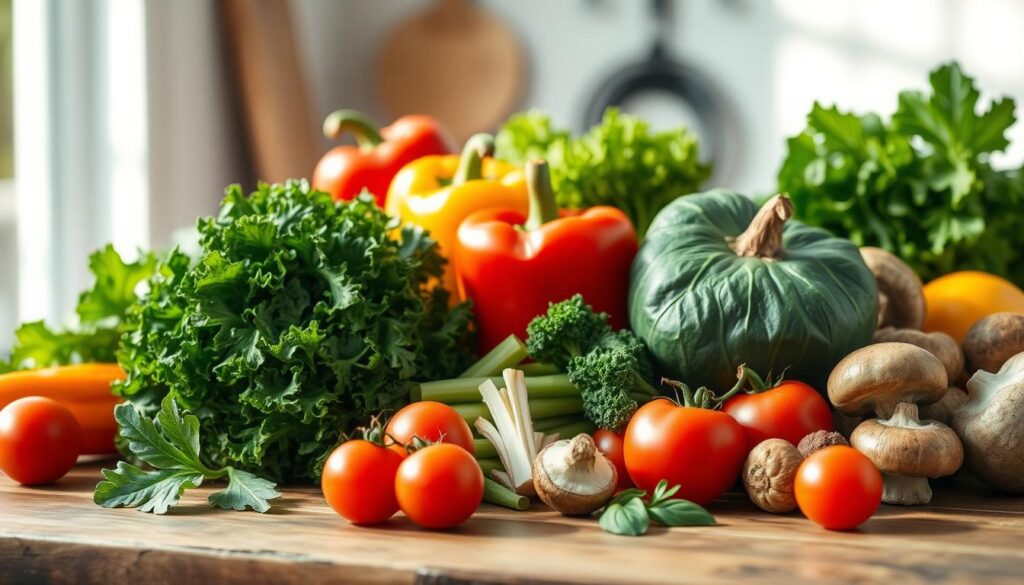Eat Well, Live Well: Your Ultimate Healthy Eating Tips
Healthy eating tips are crucial for avoiding chronic diseases like heart disease and diabetes. These conditions affect millions in the U.S. The CDC says poor nutrition leads to many preventable health issues.
Follow the Eatwell Guide’s advice: make fruits and vegetables over a third of your diet. Aim for 5 portions daily, each being 80g. Also, have 2 fish servings weekly, including oily fish, and limit red meats to 70g daily.
Drink 6–8 glasses of water daily. Keep added sugars under 12 teaspoons for a 2,000-calorie diet.
Small changes can make a big difference. Eating balanced meals boosts energy and mental focus. It also improves long-term health.
This guide offers science-backed strategies for lasting habits. Learn to choose nutrient-rich foods, plan meals, and balance portions for lasting wellness.
Key Takeaways
- 5 portions of fruits and vegetables daily (80g each).
- Drink 6–8 glasses of water to stay hydrated.
- Limit red/processed meats to 70g daily.
- Only 12% of Americans eat enough fruits, showing room for improvement.
- Choose fish twice weekly, with one portion oily fish.
- Stay under 2,300mg sodium daily (CDC recommends below 2,300mg).
Understanding Healthy Eating: What It Means
Healthy eating isn’t about strict rules. It’s about giving your body the right nutrients. Follow these balanced diet tips to make eating habits that support your health goals.
Defining Healthy Eating
Healthy eating means eating whole foods that give you the vitamins and minerals you need. It’s not about following strict diets. Nutrition advice suggests eating a variety of foods to keep your body healthy without feeling deprived.
Importance of Nutrition
Diets rich in ultra-processed foods are linked to increased mortality rates.
- Good nutrition helps your organs work well, keeps your mind clear, and boosts your immune system.
- Ultra-processed foods, like soda or sugary cereals, can increase your risk of diabetes, heart disease, and depression.
- Eating whole foods, like those in the Mediterranean diet, can lower your risk of chronic diseases and help you live longer.
Balancing Food Groups
Use the MyPlate method to make portion sizes easier:
| Food Group | Portion | Examples |
|---|---|---|
| Vegetables & Fruits | 50% | Leafy greens, berries |
| Whole Grains | 25% | Brown rice, quinoa |
| Protein | 25% | Chicken, lentils, tofu |
- Choose one protein source, like grilled salmon.
- Add one healthy fat, like avocado.
- Include one fiber-rich carb, like sweet potato.
Making small changes, like cooking at home once a week, can help you stick to a balanced diet tips. Focus on eating foods that are full of nutrients to boost your energy and vitality.
The Benefits of Healthy Eating
Healthy eating habits improve your physical and emotional health. Small changes, like eating nuts or berries instead of processed snacks, can increase energy and focus. Tips like eating more fiber and less sugar help keep your blood sugar stable and prevent midday slumps.
Improved Energy Levels
Whole grains and legumes give you energy slowly, preventing sudden drops. Adding lean proteins and healthy fats, like avocado or salmon, keeps your metabolism steady. The DASH diet helps lower blood pressure and supports heart health, keeping your energy up all day.
Enhanced Mood and Mental Health
Nutrient-rich meals improve mental clarity and mood. A 2020 study found:
“Mediterranean-style diets correlate with lower anxiety and depression symptoms.”
Foods high in omega-3s (like walnuts) and magnesium (spinach) support brain health. Avoiding too much sugar or refined carbs also helps reduce irritability and brain fog.
Long-term Health Advantages
Regular healthy choices lower risks of heart disease, diabetes, and some cancers. The American Institute for Cancer Research says diets rich in fruits and legumes can reduce cancer risk. Cutting down on trans fats and salt also protects your heart.
Even small changes, like using olive oil instead of butter, make a big difference over time. Adding regular exercise (150 minutes a week) boosts these benefits even more. Every healthy choice you make today strengthens your body for the future.
Key Components of a Healthy Diet
Building a balanced diet starts with understanding core dietary recommendations. Let’s break down what your body needs most:
Fruits and Vegetables
Fill half your plate with colorful produce. Aim for at least 5 portions daily. Choose red, orange, green, and purple options to maximize vitamins and fiber. Avoid juice overuse—it counts as one portion max.
- 1 apple = 1 portion
- ½ cup cooked spinach = 1 portion
- 15 grapes = 1 portion of dried fruit
Whole Grains
Opt for whole grains in a quarter of your plate. These retain natural fiber and nutrients unlike refined options:
| Whole Grains | Refined Grains |
|---|---|
| Quinoa, brown rice, oatmeal | White bread, white rice, pasta |
Swap refined carbs for whole grains to stabilize blood sugar and boost digestion.
Lean Proteins
Complete your plate with ¼ portion of lean proteins like:
- Fish (salmon, mackerel) twice weekly
- Legumes (lentils, chickpeas) for plant-based protein
- Chicken, turkey, or tofu
Limit red meat and processed options like bacon. Pair with healthy fats from olive oil or avocado for balanced meals.
“Colorful plates = better health.”
Follow these food and health tips to meet dietary recommendations. Prioritize nutrient-dense choices and mindful portions for long-term wellness.
Meal Planning for Success

Meal planning makes healthy eating easy. It helps you plan meals for the week. This way, you make choices that fit your life and goals.
It stops you from ordering takeout at the last minute. And it makes sure every meal is good for you.
Creating a Balanced Menu
Begin with the USDA’s plate model. It suggests half your plate for fruits and veggies, a quarter for whole grains, and a quarter for lean protein. For instance, try grilled salmon with roasted veggies and quinoa.
Add beans or lentils for plant-based meals. They’re great for variety and nutrition.
Preparing Ahead of Time
Batch cooking saves time. Cook grains, chop veggies, and marinate proteins on Sunday. This way, you’re ready for the week.
Store leftovers correctly to keep them fresh. Here’s a guide:
| Food Category | Refrigerator Storage | Freezer Storage |
|---|---|---|
| Cooked Ground Meat | 1-2 days | 3-6 months |
| Beans/Hummus | 5 days | 2-3 months |
| Chopped Veggies | 1 week | 6-8 months (frozen) |
Use airtight containers and label them with dates. This helps avoid waste. Frozen veggies keep most of their nutrients, making them a great choice.
Making Grocery Lists
Stay on track with your meal plan at the store. Apps like AnyList help you keep track of what you need. Studies show you can save 15% on groceries with lists.
Choose seasonal produce for the best taste and value. Always check your pantry first to avoid buying duplicates. Focus on items like frozen berries or whole grains. This reduces waste by 25% and makes cooking easier.
Smart Snacking Strategies
Smart snacking turns hunger into a chance to nourish your body. Studies show late-night snacking can lead to chronic diseases. So, it’s key to follow nutrition advice and clean eating guidelines. This helps keep your energy up and your health in check.
“Eatinging late at night increases the likelihood of death due to cancer or diabetes.” — 2024 Health Study
Choosing Nutrient-Dense Snacks
Choose snacks that are both protein and fiber-rich. Think apple slices with almond butter or Greek yogurt with berries. The Academy of Nutrition and Dietetics suggests snacks should be 200–300 calories to prevent overeating.
Avoid snacks with no nutritional value like chips or candy. Instead, go for options like carrots with hummus or hard-boiled eggs.
Portion Control Tips
- Use a small bowl or snack-sized container to limit portions.
- Pre-portion nuts or dried fruit into single-serving bags.
- Pause before reaching for seconds—wait 15 minutes to confirm true hunger.
Quick and Easy Snack Ideas
Pair two food groups for balanced options:
- Cucumber slices with cottage cheese (veggies + protein)
- Whole-grain crackers with avocado spread (carbs + healthy fats)
For kids, swap sugary drinks for water and choose snacks like apple slices or cheese sticks. Avoid popcorn and nuts for toddlers because of choking risks. Stick to clean eating guidelines by avoiding artificial sweeteners, even in “reduced sugar” products.
Hydration and Its Importance
Staying hydrated is key to wellness tips and a crucial nutrition tip for a healthy lifestyle. Your body needs fluids to keep cool, move nutrients, and boost energy. Did you know 75% of Americans face dehydration, which hurts focus and daily tasks?
Water’s Role in a Healthy Diet
Water is 50–70% of your body and helps with digestion and brain work. The USDA suggests 8 cups a day, but needs change. Athletes might need 1–3 extra cups when they exercise.
“Even mild dehydration can reduce cognitive performance by 10%.” — CDC
Alternative Hydration Options
While water is best, these options add variety:
- Herbal teas (no added sugar)
- Fruit-infused water
- Low-sugar vegetable juices
- Plain or unsweetened almond milk
Avoid sugary drinks too much—sodas give kids 17% of extra calories.
| Group | Recommended Intake |
|---|---|
| Adult Men | 3.7 liters (15.5 cups) |
| Adult Women | 2.7 liters (11.5 cups) |
| Pregnant/Breastfeeding | +3–4 cups |
| Older Adults | Up to 50% more than younger adults |
Tips for Staying Hydrated
Here are ways to stay hydrated:
- Carry a reusable bottle to track consumption.
- Add slices of cucumber or lemon to water for flavor.
- Drink 1 cup before meals to curb thirst cues.
Listen to your body—dark urine means you need more water. Don’t drink too much; it can mess with electrolytes. For those working outside, OSHA says drink 1 cup every 20 minutes in the heat.
Hydration isn’t the same for everyone. Mix these nutrition tips for a healthy lifestyle with mindful eating to be your best.
Mindful Eating Practices
Mindful eating changes how you eat, making it key to eating habits for health. It involves fully engaging with your food and listening to your body. Studies show it boosts awareness of hunger and fullness, essential for a balanced diet tips.
Listening to Your Body
Pay attention to your hunger and fullness signals. A study of 68 research papers found mindfulness helps you know when you’re full. Ask yourself: Am I hungry, or am I stressed? Keeping a food journal can help you see patterns and make better food choices.
Reducing Distractions
- Turn off phones or TVs during meals.
- Eat at a table instead of multitasking.
- Create a calm space to focus on flavors and textures.
The Benefits of Slowing Down
Eating slowly improves digestion and satisfaction. A 12-week study found mindful eaters lost 4 pounds by eating slower. This way, your brain can catch up with your body’s fullness, preventing overeating.
Research also links mindful eating to better blood sugar control in diabetes patients. While it’s not a quick fix for weight loss, it strengthens your connection with food. Every bite becomes more meaningful.
Incorporating Variety into Your Meals
Trying new foods makes meals fun and keeps your diet balanced. Studies show eating a variety of healthy foods can lower death risk by 42%. This shows that variety is more than just a preference—it’s a key to good health.
Explore Global Flavors
Try Thai curries with lean chicken or Mexican black bean tacos. These dishes are full of flavor and meet your protein and fiber needs. They’re great examples of smart food choices that add new nutrients without losing taste.
- Try Vietnamese pho with spinach and mushrooms for iron and vitamin C
- Make Mediterranean bowls with quinoa, chickpeas, and roasted veggies
Seasonal Eats for Better Nutrition
Eating seasonal foods like autumn apples or winter citrus is not only tasty but also budget-friendly. It helps you get more vitamins and supports local farmers. Try to add a new seasonal fruit to your diet each week.
Reinvent Classic Dishes
Mix grilled salmon with farro and roasted Brussels sprouts for a nutritious meal. Swap pasta for zucchini noodles or add kale to smoothies. Spices like turmeric or cumin can add flavor without extra salt.
“Dietary variety is the cornerstone of sustained wellness.”
Adding diverse foods to your diet can lower diabetes risk by 30%. Rotate proteins like lentils, tofu, or wild rice every month. This helps avoid getting stuck in a rut and ensures you get all the nutrients you need.
Navigating Eating Out Healthily
Eating out doesn’t mean you have to give up healthy eating tips. You can follow dietary recommendations and still enjoy meals out. First, check out restaurant menus online before you go. Places like Chipotle and Panera post nutrition facts, making it easier to find healthy choices.
Look for dishes with grilled meats, steamed veggies, and whole grains. These are usually better for you.
Reviewing Menus Ahead of Time
- Search for restaurants offering calorie counts or nutrition info online.
- Choose meals with keywords like “grilled,” “baked,” or “steamed” instead of “fried” or “creamy.”
- Plan to avoid impulse choices like high-sugar cocktails or fried appetizers.
Making Healthier Choices
Opt for salads with dressings on the side to cut calories. Swap fries for steamed veggies or a side salad. Look for the American Heart Association’s Heart-Check mark on menus for better options.
Ask servers about how your food is prepared. Request sauces or cheese on the side.
Portion Control Tips
Share entrées or ask for a to-go box to split portions. Start with a broth-based soup like Thai Kitchen’s vegetable broth to feel full before the main course. Choose half-portions if available.
Stick to one alcoholic drink and pair it with club soda. Many cocktails have over 150 calories per serving.
Overcoming Obstacles to Healthy Eating

Healthy eating goals can face challenges like time, budget, or cravings. These strategies help turn these obstacles into chances to follow clean eating guidelines and nutrition advice without needing to be perfect.
Time Crunches? Master Meal Prep
- Batch-cook staples like roasted veggies or grain bowls for grab-and-go meals.
- Choose 15-minute recipes: stir-fries, salads, or soups use pre-washed greens and frozen proteins.
- Use slow cookers or Instant Pots to set-and-forget meals while tackling other tasks.
Stretch Your Budget Without Sacrificing Nutrition
Follow clean eating guidelines by focusing on seasonal produce and store-brand items. The USDA’s Spend Smart-Eat Smart program offers $3 meals like black bean tacos. Here are some smart tips:
- Buy frozen veggies and canned beans for year-round affordability.
- Plan meals around sales and use bulk purchases for grains and legumes.
Outsmart Cravings with Mindful Choices
Cravings often signal boredom or stress, not hunger. Nutrition advice experts suggest:
- Pause before indulging—wait 10 minutes to assess true hunger.
- Swap chips for apple slices with nut butter or dark chocolate squares.
- Track cravings in a journal to spot patterns and triggers.
Small changes, like swapping soda for infused water or pre-chopping veggies for snacks, build lasting habits. Every choice brings you closer to a sustainable, obstacle-free routine.
Resources and Tools for Healthy Eating
Keeping a healthy diet is easier with the right tools. Find trusted resources for meal planning, connecting with others, and learning about food and health.
Apps and Websites for Meal Planning
MyPlate Plan helps with meal planning based on your age and activity level. Nutrition.gov has science-backed recipes and the 2020-2025 Dietary Guidelines. SOFHA offers counseling for health conditions or family needs.
Use the CDC’s Healthy Eating Guide for reliable advice.
Communities and Support Groups
Join the I Can Do It, You Can Do It (ICDI) program for support. Schools with CATCH Kids Club teach kids about heart-healthy eating. Local groups offer accountability.
Engage in forums about Mediterranean eating or budget-friendly meals to stay on track.
Educational Materials and Cookbooks
Read “A Taste of Five a Day” to increase fruit and veggie intake. The Mediterranean Eating on a Budget guide helps save money. Take the Portion Size Matters quiz to avoid overeating.
The “We Can!” series includes a 100-calorie snack guide and food classifications. Use the Weekly Meal Planner for balanced nutrition and convenience.
FAQ
What are some healthy eating tips for beginners?
How does nutrition affect overall health?
What does a balanced diet look like?
How can I improve my energy levels through diet?
What role do snacks play in a healthy eating plan?
How can I ensure I’m staying hydrated?
What is mindful eating, and how can it benefit me?
How can I incorporate variety into my meals?
What strategies can help when eating out?
How can I overcome common barriers to healthy eating?
Source Links
- Eatwell Guide: How to eat a healthy balanced diet
- Top 20 Healthy Eating Habits, According to a Dietitian
- Healthy Eating 101: Nutrients, Macros, Tips, and More
- Healthy eating basics
- Benefits of eating healthy: Heart health, better mood, and more
- 8 tips for healthy eating
- Healthy diet
- Healthy Eating Tips
- Healthy Eating Plate – The Nutrition Source
- Eating a balanced diet
- Meal Prep Guide – The Nutrition Source
- 3 Strategies for Successful Meal Planning
- Healthy Snacks to Keep You Satisfied | Mutual of Omaha
- Smart Snacking Strategies — Quality Care for Children
- How much water do you need to stay healthy?
- Water, Hydration, and Health | Nutrition.gov
- Mindful Eating – The Nutrition Source
- Mindful Eating 101 — A Beginner’s Guide
- Healthy eating: Tips for planning nutritious meals and snacks
- The Importance of Variety in Your Diet — Healthy For Life Meals | Fresh & Healthy Meal Plan Delivery
- Healthy Eating on the Go: A Guide to Dining Out, Traveling, and More
- 8 Tips on Making Healthy Choices at a Restaurant
- Dining Out Doesn’t Mean Ditching Your Diet
- Overcoming Roadblocks to Healthy Eating
- 4 Barriers to Developing Healthy Habits and How to Overcome Them
- Overcoming Roadblocks to Healthy Eating: A Guide to Better Nutrition – Geriatric House Call Dentistry
- Healthy Eating | Nutrition.gov
- Nutrition and Healthy Eating, Tools & Resources, NHLBI, NIH







